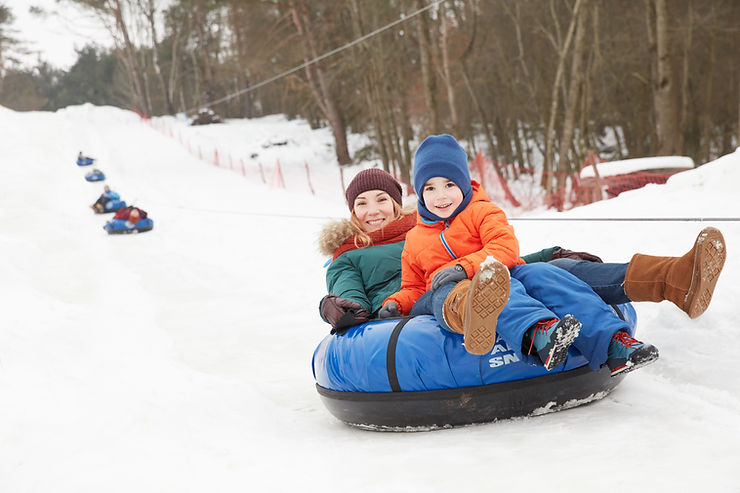Making the most of Winter 2021-2022!
- Matthew Finn

- Jan 8, 2022
- 4 min read

Here are some tips for staying safe while enjoying this winter!
Whether winter brings severe storms, light dustings or just cold temperatures, we at Orange Pediatrics will help keep you prepared to endure the cold, enjoy the outdoors, hit the slopes with Dr Morgan, or snuggle up inside. Here is some advice directly from the AAP!
What to Wear
Dress infants and children warmly for outdoor activities. Several thin layers will keep them dry and warm. Always remember warm boots, gloves or mittens, and a hat.
The rule of thumb for older babies and young children is to dress them in one more layer of clothing than an adult would wear in the same conditions.
When riding in the car, babies and children should wear thin, snug layers rather than thick, bulky coats or snowsuits. See Winter Car Seat Safety Tips for additional information.
Blankets, quilts, pillows, bumpers, sheepskins and other loose bedding should be kept out of an infant's sleeping environment because they are associated with suffocation deaths. It is better to use sleep clothing like one-piece sleepers or wearable blankets.
If a blanket must be used to keep a sleeping infant warm, it should be thin and tucked under the crib mattress, reaching only as far as the baby's chest, so the infant's face is less likely to become covered by bedding materials.
Hypothermia
Hypothermia develops when a child's temperature falls below normal due to exposure to colder temperatures. It often happens when a child is playing outdoors in extremely cold weather without wearing proper clothing or when clothes get wet. It can occur more quickly in children than in adults.
As hypothermia sets in, the child may shiver and become lethargic and clumsy. Speech may become slurred and body temperature will decline in more severe cases.
If you suspect your child is hypothermic, call 911 at once. Until help arrives, take the child indoors, remove any wet clothing, and wrap him in blankets or warm clothes.
Frostbite
Frostbite happens when the skin and outer tissues become frozen. This condition tends to happen on extremities like the fingers, toes, ears and nose. They may become pale, gray and blistered. At the same time, the child may complain that his/her skin burns or has become numb.
If frostbite occurs, bring the child indoors and place the frostbitten parts of her body in warm (not hot) water. 104° Fahrenheit (about the temperature of most hot tubs) is recommended. Warm washcloths may be applied to frostbitten nose, ears and lips.
Do not rub the frozen areas.
After a few minutes, dry and cover the child with clothing or blankets. Give him/her something warm to drink.
If the numbness continues for more than a few minutes, call your doctor.
Safe Winter Sports and Activities Set reasonable time limits on outdoor play to prevent hypothermia and frostbite.
Have children come inside periodically to warm up. Using alcohol or drugs before any winter activity, like snowmobiling or skiing, is dangerous and should not be permitted in any situation.
Ice Skating
Allow children to skate only on approved surfaces. Check for signs posted by local police or recreation departments, or call your local police department to find out which areas have been approved.
Advise your child to:
Skate in the same direction as the crowd
Avoid darting across the ice
Never skate alone
Not chew gum or eat candy while skating
Consider having your child wear a helmet, knee pads and elbow pads, especially while learning to skate to keep them safe.
Sledding
Keep sledders away from motor vehicles.
Children should be supervised while sledding.
Keep young children separated from older children.
Sledding feet first or sitting up, instead of lying down head-first, may prevent head injuries.
Consider having your child wear a helmet while sledding.
Use steerable sleds, not snow disks or inner tubes.
Sleds should be structurally sound and free of sharp edges and splinters, and the steering mechanism should be well lubricated.
Sled slopes should be free of obstructions like trees or fences, be covered in snow (not ice), not be too steep (slope of less than 30º), and end with a flat runoff.
Avoid sledding in crowded areas.
Snow Skiing and Snowboarding
Children should be taught to ski or snowboard by a qualified instructor in a program designed for children.
Never ski or snowboard alone.
Young children should always be supervised by an adult. Older children's need for adult supervision depends on their maturity and skill. If older children are not with an adult, they should always at least be accompanied by a friend.
All skiers and snowboarders should wear helmets. Ski facilities should require helmet use, but if they do not, parents should enforce the requirement for their children.
Equipment should fit the child. Skiers should wear safety bindings that are adjusted at least every year. Snowboarders should wear gloves with built-in wrist guards. Eye protection or goggles should also be used.
Slopes should fit the ability and experience of the skier or snowboarder. Avoid crowded slopes.
Avoid skiing in areas with trees and other obstacles.
Snowmobiling
The AAP recommends that children under age 16 not operate snowmobiles and that children under age 6 never ride on snowmobiles.
Do not use a snowmobile to pull a sled or skiers.
Wear goggles and a safety helmet approved for use on motorized vehicles like motorcycles.
Travel at safe speeds.
Never snowmobile alone or at night.
Stay on marked trails, away from roads, water, railroads and pedestrians.
Last Updated 11/12/2019















Comentarios